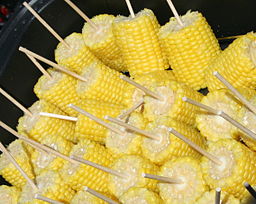On June 19th, I wrote about the official Juneteenth holiday. Today I’m sharing a memory that surfaces every year when June 19 comes around.

In my corner of the world, Juneteenth marks the time corn is ripe and ready to eat. Although most people prefer sweet corn, my family ate field corn–roasting ears, commonly pronounced ros’nears–the same kind cattle eat after it’s dried. Considering the amount we ate or froze to eat (usually sheared off the cob and served creamed) after the season ended, it’s a wonder there was any left for the cows.
My father’s uncles grew corn. When it was ready, we made a pilgrimage (or two or three . . . ) to the cornfield on Uncle Maurice’s place. Picking was an itchy job. The men usually took care of that. Shucking and removing silk was no picnic either, but everyone participated. I helped shuck (also an itchy job) and silk, but I wasn’t strong enough to chop the stem end off. More to the point, my chopping technique lacked accuracy, so I was best occupied elsewhere.

The variety was Yellow Dent–so-called because the kernels have “an indentation in the crown of each kernel.” Wikipedia helped me with crown; I didn’t know the word. (I use capital letters in the name because the it deserves them.)
Field corn has a heavy, musky taste; or maybe it’s musty. Neither word is correct, but they’re the best I can do. No matter–boiled, slathered with butter and covered with a sprinkling of salt, it’s delicious.
Several years ago, I mentioned Yellow Dent to some of the teacher-farmers I worked with; they’d never heard of it. I assumed that over the years it had been replaced by hybrids. A paragraph in Wikipedia corrected the assumption:
Most of the corn grown in the United States today is yellow dent corn or a closely related variety derived from it. Dent corn is the variety used in food manufacturing as the base ingredient for cornmeal flour (used in the baking of cornbread), corn chips, tortillas and taco shells. Starch derived from this high-starch content variety is turned into plastics, as well as fructose which is used as a sweetener (high-fructose corn syrup) in many processed foods and soft drinks.
So Yellow Dent is still with us, serving a number of worthwhile purposes.
Its widespread use in the American diet has brought corn under scrutiny in recent years. Corn syrup is widely used as a sweetener and is an ingredient in many refined foods. According to the U. S. Department of Agriculture, in 2001, Americans consumed 62.6 pounds of high-fructose corn syrup. Corn is also used as cattle- and chicken feed, and is indirectly responsible for the high doses of antibiotic given to cattle. Scientific American, citing a 2008 study in which researchers analyzed meat from hamburgers and chicken sandwiches produced by three separate fast food companies in six cities across the United States, reported that “93 percent of the tissue that comprised the hamburger meat was derived from corn.” More recently, it’s been linked to the obesity epidemic.
Other sources claim that health problems arise from a diet rich in processed foods containing products derived from corn. One nutritionist says,

A friend recently remarked that ours is the last generation to eat “real food.” The corn I remember wasn’t organic, but it was real food. And it makes for happy memories.